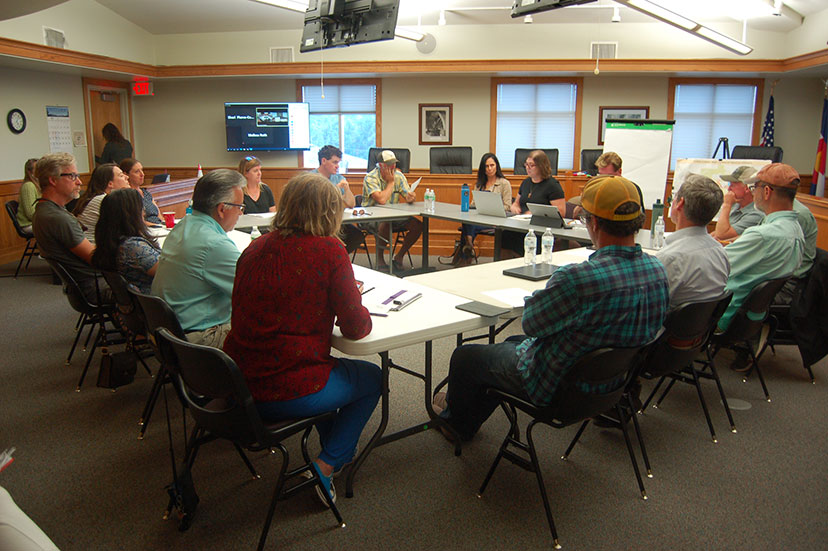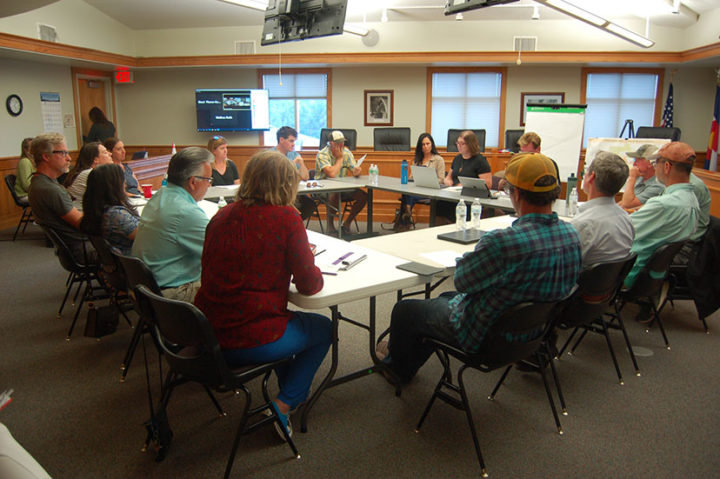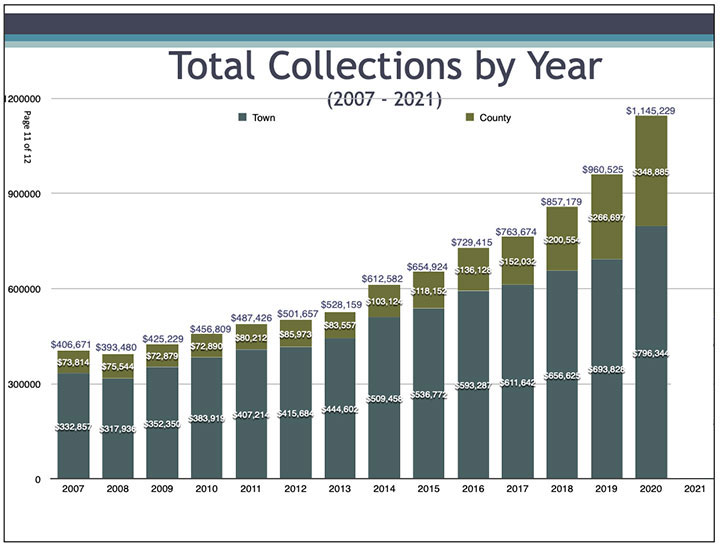A roomful of mostly volunteers gathered at the Pagosa Springs Town Hall, in the Council Chambers, on Thursday evening, July 29, to debate a number of pending issues. I say, “mostly volunteers”, because the Town Planning Commission, seated at the northwest corner of the table, are purely volunteers. And the Pagosa Springs Area Tourism Board, which had positioned themselves mainly around the southeast corner of the table, are also purely volunteers.
But the Town Council, which occupied the southwest corner of the table, are only “mostly volunteer” because they receive a small monthly stipend for serving their constituents. $200 per month. Except for the Mayor, who receives a $300 monthly stipend.
Also seated at the table were certain paid employees: Town Manager Andrea Phillips, Tourism Director Jennie Green, Town Planning Director James Dickhoff… along with consultant Jennifer Gardner, representing LoganSimpson, the Fort Collins-based consulting firm hired to help revise the Town’s Land Use and Development Code (LUDC).
Out in the audience were a few business owners or managers, and a couple of community activists. A couple dozen people were attending via Zoom.
Perhaps the most important question — “How should we allocate tax revenues?” — was not on the table.
But two other concepts were front and center.
The Carrot. And the Stick.
We don’t often see the Planning Commission and the Tourism Board sitting at the same table. In fact, I would venture to say that Pagosa Springs has never before experienced such an event.
The Planning Commission is charged mainly with hearing development applications and making recommendations about those developments to the Town Council. The Planning Commission also makes recommendations concerning the LUDC and various land use policies. Parking issues, for example. Zoning changes. Easements. Vacation rental policies.
Did I just find myself writing, “Vacation rental policies”?
“Vacation rentals” definitely qualify as a “land use”, and as such, are properly located in the Planning Commission’s wheelhouse. Pretty much any topic that has to do with ‘planning’ the ongoing development of Pagosa Springs, or concerning the land uses within the Town boundaries, could be considered to be within the Planning Commission’s area of responsibility.
The Pagosa Springs Area Tourism Board, on the other hand, has a rather simple and limited range of duties. Their job is to make recommendations, to the Town Council and the Archuleta Board of County Commissioners, concerning the expenditure of about $1 million in annual Lodgers Tax revenues. How should that $1 million be spent to encourage tourism and enhance the tourist experience?
By my calculations, the Tourism Board has spent, since 2007, in excess of $8.9 million encouraging tourism and enhancing the tourist experience.
To put things in slightly different terms, the Tourism Board has been subsidizing one particular Archuleta County industry sector — the tourism industry — to the tune of $8.9 million dollars.
We might notice, in the chart above, that the amount of annual tax revenue handled by the Tourism Board, in 2020, had more than doubled since 2012. (Hmmm. So have median housing prices… Possible correlation?)
Historically, few people in Pagosa have expressed discomfort with the idea that millions of dollars in public revenues have been spent to subsidize one particular local industry since 2007.
But recently, the Town Planning Commission did exactly that. Expressed their discomfort.
Not only did the Planning Commission express their discomfort; they actually made a unanimous recommendation that a portion of the $1 million in annual Lodgers Tax revenues ought to be “reallocated” in service of a rather different industry: the workforce housing industry. To the “maximum extent possible”.
The wording of their recommendation, per the July 27 meeting minutes:
Commissioner Posey moved to recommend instituting a 2-year ownership prior to applying for a short-term rental, increase STR license fee by at least a factor of 12 for non-owner-occupied units 100% dedicated to workforce housing, reallocate lodgers’ tax to the maximum extent possible to workforce housing, one short-term rental license per property, Commissioner Adams seconded. Carried.
The Pagosa Springs Area Tourism Board was not entirely pleased with the Planning Commission for making these recommendations… which is understandable, considering that they’d been granted sole authority to recommend the expenditure of $8.9 million since 2007, without anyone trying to butt in on their financial territory.
So when the Tourism Board learned that the Town Council would be meeting with the Planning Commission to discuss topics of mutual interest (mutual, that is, between Council and Commission) the Tourism Board asked politely to be invited to the same work session.
Thus, the well-populated table at Town Hall on July 29.
At the moment, Pagosa Springs has a very limited “workforce housing industry,” even if we wanted to subsidize it. As far as I know, within the entire 1350 square miles of Archuleta County, a total of about 34 ‘low-income’ dwelling units are currently under construction — and very few dwelling units that would qualify as ‘workforce housing’. Maybe a dozen?
At the same time, we are hearing from more and more working individuals and families, here in Archuleta County, who are living in vehicles or tents. But our tourists seem to have an abundance of housing options.
These facts could be construed to indicate abject failure on the part of the Town Planning Commission, and on the part of the Archuleta County Planning Commission as well… if we assume that these appointed boards are supposed to be ‘planning’ for a well-rounded, diverse community. But then, we must recognize that neither of these Planning Commissions is assigned a budget with which to encourage a well-rounded, diverse community. They have only ‘carrots’ and ‘sticks’.
The Tourism Board, on the other hand, has more money than they know what to do with.
So there we were, in the Council Chambers on Thursday evening, with the Council in one corner, the Planning Commission in another corner, and the Tourism Board in yet another corner.
Mayor pro tem Madeline Bergon kicked off the meeting.
“So the purpose of this work session is to really discuss our Land Use and Development Code and provide feedback to our consultants, LoganSimpson; we do have Jennifer Gardner here today, who is going to be presenting. They really need clarification on policy, regarding housing issues, for the Land Use and Development Code.
“So, with all of our powers combined, I am very hopeful that we can make positive steps towards finding solutions, together.
“I do want to be very clear, though, that we are not here to talk about funding mechanisms. We are not here to talk about who is going to lead the charge on managing housing. We are here primarily to talk about policy and how it is written in the Land Use and Development Code…”
An introduction I personally found to be very weird. Clearly, the Tourism Board had not come to this meeting to discuss land use policy; as a group, they have very little expertise in designing land use policies. The Tourism Board had showed up to talk about the Lodgers Tax, and whether it ought to be reallocated.
But apparently, Mayor pro tem Bergon… was not going to allow that conversation to take place?



